NorthEast Radio Watch 12/8/2025: Cichon’s Back in Buffalo
In this week’s issue… Veteran newsman returns - Remembering NY's Leitner, RI's Jones - CT AM saved - Maine AM moves - "Indie" adds suburban signals
Here we are again, for the seventeenth year of recapping another twelve months in the life of radio and television across NERW-land. When we gathered here for last year’s Year in Review, we didn’t have much good to say about 2010: between job cuts and budget cuts and consolidations, it was a year for treading water while awaiting better times. 2011, alas, proved to be more of the same, albeit with a few more bright lights peering around the end of the tunnel. So as we always do, we’ll start things off with our Top Ten Stories of the Year. (We’ll continue next Monday, January 2, with The Year in Programming and People, The Year in Sales and our annual obituary roundup – and maybe a Rant somewhere in there, too.)
While many of 2011’s top stories proved to be continuations of storylines that started in 2010 or before, the year’s biggest story in the region was one that nobody saw coming at the start of 2011. Back then, Randy Michaels was out of radio for the most part, keeping a low profile after being ousted as CEO of Tribune after a rocky ride in the worlds of newspapers and TV, unfamiliar territory for a controversial leader best known for making “the noise you can’t ignore” as a radio programmer and corporate leader at Jacor and later Clear Channel.
 While Michaels had ventured into spoken-word radio in the latter part of his radio career (rebuilding WLW into “The Big One,” for instance), he made his name in FM music radio, and so when he emerged from his post-Tribune seclusion to announce the formation of a new radio group, Merlin Media, it wasn’t at all obvious where he was heading with his first acquisitions. Backed by venture capital from Chicago-based GTCR, Merlin bought three stations from Emmis in a $120 million deal: Chicago’s WLUP (97.9) and WKQX (101.1) and New York’s struggling rocker WRXP (101.9), touching off weeks of heated speculation about what Michaels had in mind for the signals.
While Michaels had ventured into spoken-word radio in the latter part of his radio career (rebuilding WLW into “The Big One,” for instance), he made his name in FM music radio, and so when he emerged from his post-Tribune seclusion to announce the formation of a new radio group, Merlin Media, it wasn’t at all obvious where he was heading with his first acquisitions. Backed by venture capital from Chicago-based GTCR, Merlin bought three stations from Emmis in a $120 million deal: Chicago’s WLUP (97.9) and WKQX (101.1) and New York’s struggling rocker WRXP (101.9), touching off weeks of heated speculation about what Michaels had in mind for the signals.
Michaels fueled much of that speculation with a series of high-profile hires that seemed to point to some sort of talk format aimed at younger women, an idea that gained traction when WRXP’s rock format went away on July 14 to be replaced by “FM New,” a mostly-jockless AC format featuring frequent mentions of shoes and chocolate. But what emerged from that stunt on August 12 wasn’t talk and wasn’t explicitly aimed at women. Instead, WEMP (“FM News 101.9”) took on New York’s all-news giants WCBS and WINS with a fairly straightforward all-news wheel of its own that (when it was working right) was hard to distinguish from the established players, aside from being on the FM dial.
Without much publicity (that’s coming, Merlin promised, once all the kinks are out of the new format), WEMP and its Chicago sister station (WWWN, later WIQI) failed to gain much ratings traction at year’s end, leading many in the radio community to quickly dismiss Michaels’ latest venture as a flop. But Michaels appears to be taking a longer view: at year’s end, Merlin announced a $22.5 million deal to add a Philadelphia signal, buying WKDN (106.9 Camden NJ) from Family Stations, on the rocks after founder Harold Camping’s blown prediction of global apocalypse earlier in the year.
So while Merlin may have been a surprise entry in the 2011 headlines, we can say with some certainty we’ll be talking about it quite a bit – for better or worse – when we join you again for next year’s roundup.
When 2011 began, Nevada-based Citadel Broadcasting didn’t want to be acquired by Cumulus Broadcasting, rejecting several purchase offers from the Atlanta-based company that was already the largest radio-only operator in the country. But in February, Cumulus offered $37 per Citadel share and negotiations restarted in earnest, resulting weeks later in a $2.5 billion deal that brought the companies together to become the unquestioned number-two player in American commercial radio with nearly 600 stations in hundreds of markets.
 Once the deal was done, it moved with surprising speed through the regulatory machinery, in part because the two companies had very little overlap. While the old Cumulus was primarily a small- and medium-market operator, building its strengths in places like Danbury, York and Bangor, Citadel was still working through its own fairly recent (and in retrospect, overpriced) addition of the former ABC Radio signals like New York’s WPLJ and WABC to its established medium-market bases in cities such as Syracuse, Erie and Portland.
Once the deal was done, it moved with surprising speed through the regulatory machinery, in part because the two companies had very little overlap. While the old Cumulus was primarily a small- and medium-market operator, building its strengths in places like Danbury, York and Bangor, Citadel was still working through its own fairly recent (and in retrospect, overpriced) addition of the former ABC Radio signals like New York’s WPLJ and WABC to its established medium-market bases in cities such as Syracuse, Erie and Portland.
The merger forced only a handful of spin-offs: in central Pennsylvania, the new Cumulus swapped formats, retaining the Harrisburg-market 93.5 signal but sending its intellectual property (the WTPA calls and rock format) down the dial to 92.1 to be spun off along with WCAT-FM (102.3 Carlisle), as well as WELJ (104.7 Montauk NY). By year’s end, those spins hadn’t happened, but Cumulus had spun off plenty of staffers from the former Citadel operations: when the sale closed in November, it brought some deep cutbacks around the region, including at least a dozen WABC/WPLJ staffers.
Can Cumulus pull off what Clear Channel and CBS never could, making small markets and major markets function in tandem to achieve major cost savings? The early returns don’t look good: Cumulus’ cuts have left WABC with even less local presence than it had in its pared-down Citadel days, while in other former ABC markets the Cumulus axe has eviscerated longtime local talents at KGO in San Francisco and KABC in Los Angeles. And in the smaller markets, the Cumulus formula has all but eliminated live, local voices outside of morning and afternoon drive.
(The new Cumulus was hardly alone there: Clear Channel made its own round of national cuts in October, eviscerating local talent such as Beth Adams at Rochester’s WHAM, Jeni Gipe at Harrisburg’s WRVV, Jim Reith at WSYR in Syracuse and most of its airstaff in Williamsport, PA. Another group player in the region, Townsquare, also cut staff at its clusters in Buffalo, Albany and elsewhere in the fall.)
Commercial broadcasters weren’t alone in seeking cost savings from consolidation. Across the region, 2011 was a year when public radio and TV stations tried to rebound from higher costs and lower public funding by combining services and joining forces.
 Buffalo offered perhaps the best example of several aspects of the trend: after years of offering competing (and sometimes complementary) news-talk services, SUNY’s University at Buffalo agreed to sell its WBFO (88.7) to Western New York Public Broadcasting, which will merge WBFO into its existing WNED TV and radio operation and will likely sell off WNED(AM).
Buffalo offered perhaps the best example of several aspects of the trend: after years of offering competing (and sometimes complementary) news-talk services, SUNY’s University at Buffalo agreed to sell its WBFO (88.7) to Western New York Public Broadcasting, which will merge WBFO into its existing WNED TV and radio operation and will likely sell off WNED(AM).
UB was hardly alone in seeking to unload a broadcast license it saw as far from its core educational mission: in Pittsburgh, Duquesne University made big headlines when it completed the $6 million sale of its WDUQ (90.5) to a new venture called Essential Public Media. A joint venture of the principals behind Colorado-based Public Radio Capital and the much smaller Pittsburgh-based WYEP (91.3), EPM took over WDUQ on July 1, killing off the station’s jazz legacy to bring in a news-talk format under new calls WESA, staffed largely by non-Pittsburghers. (Many of WDUQ’s jazz staffers moved on to a new venture, Pubradio, led by former WDUQ chief engineer Chuck Leavens.)
Several New England-based public broadcasters used 2011’s low station prices to extend their networks: in Connecticut, the WSHU network bought Cox’s WNLK (1350 Norwalk) and WSTC (1400 Stamford) for $500,000 and began supplying programming to Yale’s WYBC (1340 New Haven) and Dennis Jackson’s WQQQ (103.3 Sharon), while Connecticut Public Radio’s WNPR began programming WAIC (91.9 Springfield MA) for American International University. In Rhode Island, it was college radio that took the hit as Bryant University handed over the reins at newly powered-up WJMF (88.7 Smithfield) to Boston’s WGBH for an expansion of its “Classical New England” service, while Brown Student Radio lost its leased-time perch on WELH (88.1 Providence) when Rhode Island Public Radio, renamed “RI NPR,” took over that FM facility as part of a big statewide expansion. In western Massachusetts, WFCR (now “New England Public Radio”) made plans to build new Springfield studios while adding additional FM signals in the Berkshires, and up north networks such as Vermont Public Radio and North Country Public Radio began to bring new signals on line that they’d obtained in the 2007 filing window.
Consolidation hit TV as well: at year’s end, New York state’s public TV stations were well underway on the construction of a new hubbed master-control facility at the new studios of WCNY in downtown Syracuse. And then there was New Jersey…
All across the country, governors trying to close big state budget holes looked at state-run public broadcasters as a potential source of cuts, but in 2011 only one of those governors gathered the political steam to actually eliminate the operation. That, of course, was New Jersey’s Chris Christie, who made the elimination of NJN television and radio a major campaign platform. For the first few months of 2011, it wasn’t at all clear that Christie would have any more luck than some of his fellow Republicans elsewhere in actually carrying out that campaign promise: Democrats in the state legislature appeared poised to block Christie from pulling the plug on NJN, the only statewide broadcast news operation. But Christie prevailed by a handful of votes, ending state funding of NJN on June 30 with a deal that kept the signals from going dark.
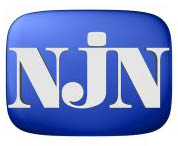 It’s not yet clear that Christie’s NJN shutdown will result in any huge immediate savings to the Garden State, though: lawmakers blocked the governor from selling NJN’s most valuable assets, its four UHF television licenses and the towers that went along with them. Instead, the TV stations (now known as “NJTV”) are being operated by New Jersey Public Media, a consortium of New York public broadcaster WNET and well-connected New Jersey political broadcaster Steve Adubato, with most of the revenue from underwriting, membership and tower leases going to WNET instead of the state.
It’s not yet clear that Christie’s NJN shutdown will result in any huge immediate savings to the Garden State, though: lawmakers blocked the governor from selling NJN’s most valuable assets, its four UHF television licenses and the towers that went along with them. Instead, the TV stations (now known as “NJTV”) are being operated by New Jersey Public Media, a consortium of New York public broadcaster WNET and well-connected New Jersey political broadcaster Steve Adubato, with most of the revenue from underwriting, membership and tower leases going to WNET instead of the state.
NJN’s nine radio licenses were split between two buyers, Philadelphia’s WHYY and New York’s WNYC, returning only a pittance to the state (less than $2 million for the licenses), and the state is still on the hook for benefits for 130 laid-off NJN staffers and the network’s white-elephant Trenton headquarters building, which is now up for sale in a very soft real-estate market.
As big a story as media consolidation has been in the U.S., it’s been even more intense in Canada, where a tiny handful of companies now enjoy dominant positions astride almost all forms of media from newspapers to cable to broadcast TV to radio. In Francophone Canada, Cogeco took its place as one of those giants in February as it closed on its C$80 million acquisition of Corus’ Quebec radio interests, creating a dominant cluster in Montreal and near-monopoly control of many smaller markets.
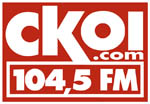 Cogeco wasted little time centralizing many of those smaller markets, expanding the Montreal-based “CKOI” brand to semi-localized satellites in Trois-Rivieres, Sherbrooke, Gatineau/Ottawa and elsewhere and in the process completely wiping out some familiar broadcast identities dating back decades – no more “CHLT” in Sherbrooke or “CHLN” in the Mauricie, for instance.
Cogeco wasted little time centralizing many of those smaller markets, expanding the Montreal-based “CKOI” brand to semi-localized satellites in Trois-Rivieres, Sherbrooke, Gatineau/Ottawa and elsewhere and in the process completely wiping out some familiar broadcast identities dating back decades – no more “CHLT” in Sherbrooke or “CHLN” in the Mauricie, for instance.
But Cogeco’s growth hit some roadblocks, too: it was forced to abide by CRTC orders to spin off two signals in the Quebec City market and one in Sherbrooke (which ended up being closed down completely in December when Cogeco claimed it had been unable to find a suitable buyer) – and it lost out on a bid to reactivate two big, dormant AM facilities in Montreal…
What looked like a “sure thing” deal for Cogeco in Montreal quickly turned into a more complicated story. In May, the company announced it had worked out a deal with Quebec’s transport ministry to put two new all-traffic signals on the air to help Montreal drivers navigate some complex new construction areas. With the help of a hefty provincial subsidy, Cogeco planned to broadcast in French on 690 (the old Corus CINF) and in English on 940 (the old Corus CINW), using the transmitter site at Kahnawahke that it had inherited as part of the Corus purchase.
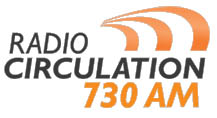 Competing broadcasters, however, cried foul, filing competing applications and delaying what Cogeco had hoped would be a straightforward CRTC process. Faced with provincial deadlines to get the traffic service on the air or lose the subsidy, Cogeco blinked in September, withdrawing its 690 application and instead launching French-language “Radio Circulation” on the venerable CKAC (730) and killing off the French sports-talk format that had been there. Cogeco was then dealt another blow in November when the CRTC denied its 940 application for English traffic, instead awarding the 50 kW facility to a consortium that included veteran broadcaster Paul Tietolman for a talk format that will compete directly against Cogeco’s market-leading CHMP (98.5).
Competing broadcasters, however, cried foul, filing competing applications and delaying what Cogeco had hoped would be a straightforward CRTC process. Faced with provincial deadlines to get the traffic service on the air or lose the subsidy, Cogeco blinked in September, withdrawing its 690 application and instead launching French-language “Radio Circulation” on the venerable CKAC (730) and killing off the French sports-talk format that had been there. Cogeco was then dealt another blow in November when the CRTC denied its 940 application for English traffic, instead awarding the 50 kW facility to a consortium that included veteran broadcaster Paul Tietolman for a talk format that will compete directly against Cogeco’s market-leading CHMP (98.5).
The 690 frequency, meanwhile, will go English for the first time in its Montreal history, becoming the new home of Bell Media’s CKGM, which will in turn yield up its existing 990 facility to a French-language station targeting Montreal’s gay and lesbian community.
Other large Canadian cities also saw at least a small revival of interest in AM as space on the FM dial became scarce. The CRTC expects to fill more long-vacant Montreal AM frequencies (such as 600 and 850) in 2012, while in the Toronto suburb of Mississauga there’s a new English-language news-talk signal heading for 960. In Ottawa, Radio Ville-Marie put a new religious signal on at year’s end at 1350 (CIRA-5, relaying Montreal’s CIRA), with applications pending for at least one more frequency as well.
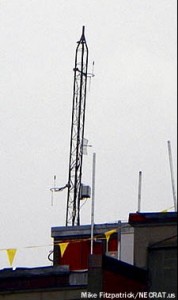
Wild weather was a big story all over the country in 2011, but in the northeast Mother Nature saved her worst until the year’s second half. In June, tornadoes hit Springfield and tracked into central Massachusetts, silencing many stations temporarily and causing more serious damage to a handful of signals.
(WSCB 89.9 at Springfield College, right in the path of one of the tornadoes, remained silent at year’s end.)
Then came the coastal storms: Hurricane Irene in late August took out the tower of WJDA (1300 Quincy MA), which ended up on a temporary longwire antenna for the rest of the year, and caused massive flooding up the Connecticut River Valley that wreaked havoc with stations in New Hampshire and Vermont.
A week later, the Susquehanna River began its own rise, affecting stations from Harrisburg north into New York’s Southern Tier and devastating communities such as Binghamton and Owego, where WEBO (1330) lost its downtown studio and had to operate first from a transmitter-site trailer and then, for two months, from owner Dave Radigan’s living room up on a hill.
In just about any other year of writing NERW, the move of Boston sports giant WEEI to the FM dial would have ranked somewhere significantly higher than the number-eight spot. But by the time Entercom finally pulled the trigger on September 12, killing off adult hits “Mike FM” WMKK (93.7 Lawrence) to roll out a new WEEI-FM, the move almost looked like an afterthought in an era when FM was fast becoming the default location for spoken-word formats seeking listeners under 55.
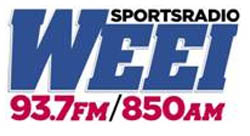 CBS Radio finally pushed WEEI over the FM cliff with its own WBZ-FM (98.5 the Sports Hub), which in its first two years on the air posted ratings that began to significantly cut into WEEI’s longtime ownership of the Boston sports market. With little support from its longtime play-by-play staples (we don’t really need to recap the Red Sox September slump, do we, nor the NBA lockout that kept the Celtics off the parquet until year’s end), Entercom finally had no choice but to sacrifice the cash cow of jockless “Mike FM” to give WEEI a fairly equal platform on which to compete against CBS.
CBS Radio finally pushed WEEI over the FM cliff with its own WBZ-FM (98.5 the Sports Hub), which in its first two years on the air posted ratings that began to significantly cut into WEEI’s longtime ownership of the Boston sports market. With little support from its longtime play-by-play staples (we don’t really need to recap the Red Sox September slump, do we, nor the NBA lockout that kept the Celtics off the parquet until year’s end), Entercom finally had no choice but to sacrifice the cash cow of jockless “Mike FM” to give WEEI a fairly equal platform on which to compete against CBS.
CBS continued its own FM sports push in 2011, ditching fading rocker WYSP (94.1 Philadelphia) to put sports giant WIP on FM (it retained its AM 610 simulcast as well, using it for occasional conflict games) and signing the Pittsburgh Pirates for KDKA-FM (93.7 the Fan).
The spoken-word FM juggernaut continued elsewhere, too: there was WEMP in New York, of course; in upstate New York, Clear Channel started the year by putting Syracuse’s WSYR on FM, while in Buffalo, Entercom gave WBEN (930) a rimshot FM simulcast on WLKK (107.7 Wethersfield Township) in April. Even smaller markets caught on to the trend, with Jeff Andrulonis’ Colonial group installing its WVTT news-talk programming on a full-power Olean, NY signal (the former WBYB 96.7 Portville) in the fall.
Here’s another story that started in 2010 and just kept chugging along into 2011: those little FM translator signals of 250 watts or less kept making big news as innovative small (and sometimes not-so-small) broadcasters found new uses for them.
 More AM stations adopted FM translators as a way to reach audiences that have abandoned the senior band or to launch what amounted to “new” stations in markets with no space for more full-power FM signals. In Pittsburgh, urban listeners mourning the loss of the old WAMO received at least a partial substitute in May when Tim Martz launched a new “WAMO” on the daytimer at 660 that used to be WPYT – and on a translator, W261AX (100.1), with at least adequate coverage of the core of the market. In Binghamton, Equinox Broadcasting used a combination of HD Radio subchannels (on its WRRQ 106.7) and two FM translators atop Ingraham Hill to launch new formats into the market, soft AC “Sunny 107” in the summer and AAA “104.5 the Drive” in the fall. In New York’s Hudson Valley, Sunrise Broadcasting followed up the summertime launch of full-power oldies WGNY-FM (98.9 Rosendale) with a new dance format, “Drive FX,” heard on WGNY’s HD2 and several translators around the region.
More AM stations adopted FM translators as a way to reach audiences that have abandoned the senior band or to launch what amounted to “new” stations in markets with no space for more full-power FM signals. In Pittsburgh, urban listeners mourning the loss of the old WAMO received at least a partial substitute in May when Tim Martz launched a new “WAMO” on the daytimer at 660 that used to be WPYT – and on a translator, W261AX (100.1), with at least adequate coverage of the core of the market. In Binghamton, Equinox Broadcasting used a combination of HD Radio subchannels (on its WRRQ 106.7) and two FM translators atop Ingraham Hill to launch new formats into the market, soft AC “Sunny 107” in the summer and AAA “104.5 the Drive” in the fall. In New York’s Hudson Valley, Sunrise Broadcasting followed up the summertime launch of full-power oldies WGNY-FM (98.9 Rosendale) with a new dance format, “Drive FX,” heard on WGNY’s HD2 and several translators around the region.
But the biggest translator story of the year, bar none, was in New York City, where we spent much of the year chronicling the peregrinations of a new FM translator from 107.1 to 106.5 to 106.3 and from Brooklyn to Union, New Jersey to the roof of Four Times Square in Manhattan, where the signal (as W292DV 106.3) was poised to become a new country outlet for at least the core of the market, relaying the HD2 channel of Clear Channel’s WLTW (106.7).
No sooner did W292DV sign on from its new home, though, than New Jersey’s Press Communications struck back, citing interference to its own country station, WKMK (106.3 Eatontown) and mustering a pile of listener letters and e-mails to back up its case – and so the little translator owned by Michael Celenza had to shut down as quickly as it had started up. It’s not gone for good, though: an application to move down the dial to 104.7 has been pending since October, and we’ll be following it closely into the new year.
After several years of frenzied station purchases all over the country while other broadcasters were laying low, even California-based EMF Broadcasting pulled back a bit in 2011. But the big national parent company of religious networks “K-Love” and “Air 1” added a huge new market to its reach on May 30 when it completed its takeover of the former WCTZ (96.7) from Cox. The station had already changed city of license from Stamford, Connecticut to nearby Port Chester, NY, and the K-Love debut on the renamed WKLV-FM coincided with the sign-on of its new transmitter site atop the Trump Plaza building in downtown New Rochelle, providing a strong signal to much of Westchester, the Bronx and northern Queens and a usable fringe signal to much of Manhattan, Brooklyn, Nassau County, Fairfield County, Connecticut and even parts of north Jersey.
The other religious group expanding its footprint in 2011 was the Catholics: after making some big splashes in markets including Pittsburgh, Boston and Portland in 2010, this past year found Catholic broadcasting groups adding signals in Elmira (Holy Family’s WMTQ 88.1), Harrisburg (WHYF 720, the former WWII), Worcester (WNEB 1230) and Bangor (WTBP 89.7, the latest arm of Portland-based “Presence” radio).

It might not quite have been a top-ten story, but we can’t end our headline review of the year without at least noting the demolition of the oldest AM tower site in New England and, we believe, anywhere in the country: just weeks after Boston’s WBZ (1030) celebrated its 90th anniversary September 19, the current owners of the original WBZ towers atop the old Westinghouse plant in East Springfield carried out their long-delayed plans to demolish the site, making room for a shopping center or casino development.
On November 5, WBZ engineers joined other ham radio operators at the site to transmit from the towers one last time via special-event station W1Z – and just minutes after W1Z signed off, demolition crews moved in, toppling the two ancient towers in a matter of hours and closing the chapter on nine decades of broadcast engineering history.
Coming Monday, January 2 on fybush.com – The Year in Station Sales, The Year in People and Programming, and our annual obituary roundup. Have your own “Top 10” nomination? Weigh in now in the comments, below…
In this week’s issue… Veteran newsman returns - Remembering NY's Leitner, RI's Jones - CT AM saved - Maine AM moves - "Indie" adds suburban signals
In this week’s issue… Scripps stations face takeover - Sinclair moves more affiliations - CT stations sold - Maine AM surrendered - Remembering WVBR's Shapiro, WABC's Morgan
In this week’s issue… CT TV legend succumbs to cancer - Remembering PA's Adams - FCC still stalled by shutdown - Pittsburgh morning host exits
In this week’s issue… FCC faces reopening challenges - Veteran Boston anchor retires - Morning shift in Toronto - NYC FMs expand reach